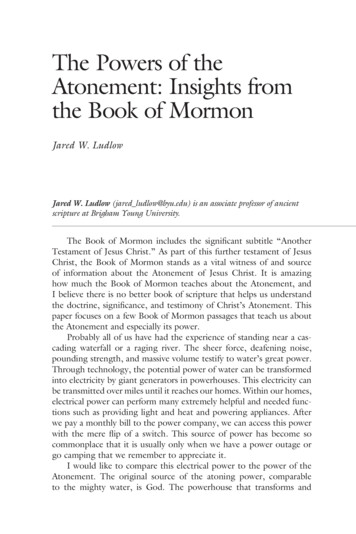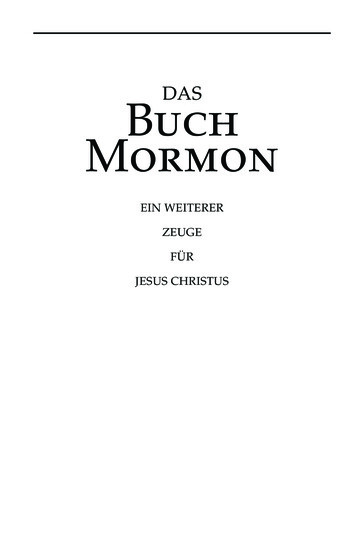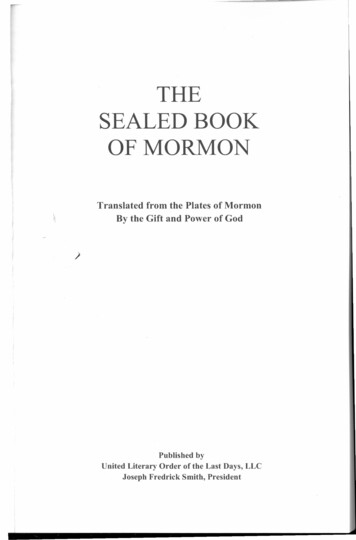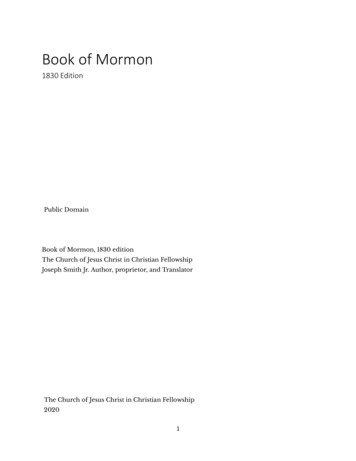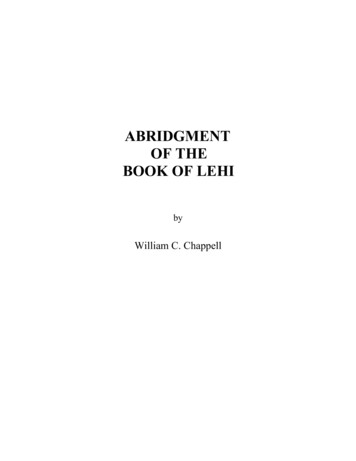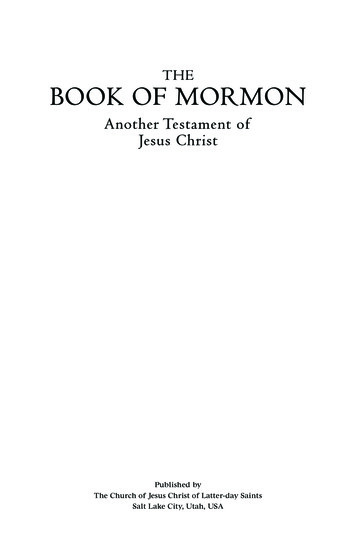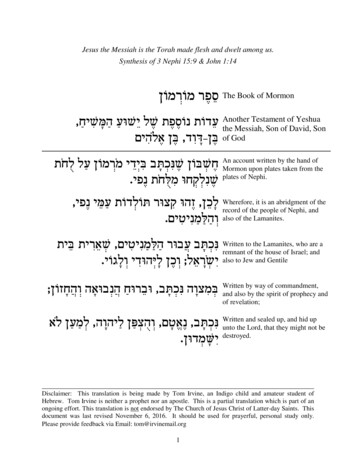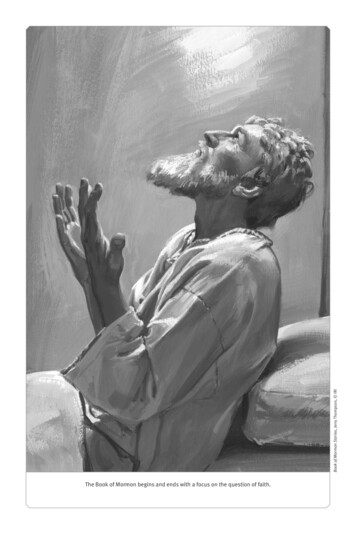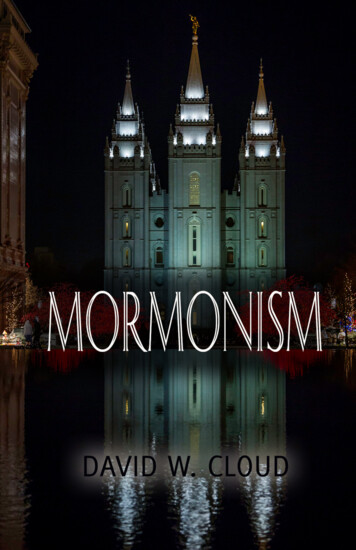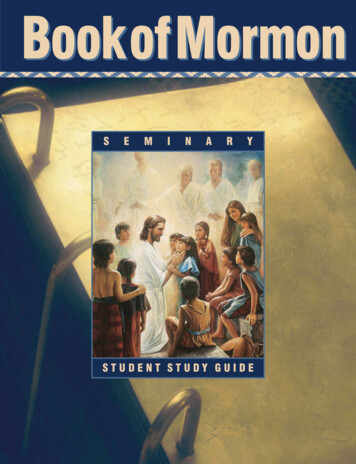
Transcription
BookofMormonSEMINARYSTUDENT STUDY GUIDE
Book of Mormon Student Study GuidePrepared by theChurch Educational SystemPublished byThe Church of Jesus Christ of Latter-day SaintsSalt Lake City, Utah
Pages 84–85, 87, 99, 102, 104, 106, 110, 113, 132–33, 135, 137, 142,145–46, 149, 151, 158, 202: Drawings from The Book of Mormon Story 1966 Ronald K. Crosby. 2000 by Intellectual Reserve, Inc.All rights reservedUpdated 2008Printed in the United States of AmericaEnglish approval: 3/07
Table of ContentsHow to Use This Manual . . . . . . . . . . . . . . . . . . . . . . . . . . . . . . . . 1Studying the Scriptures . . . . . . . . . . . . . . . . . . . . . . . . . . . . . . . . . 2Book of Mormon Reading Chart . . . . . . . . . . . . . . . . . . . . . . . . . . 7Welcome to the Book of Mormon . . . . . . . . . . . . . . . . . . . . . . . . . 82 Nephi 21–222 Nephi 23–242 Nephi 252 Nephi 26Introductory Pages to the Book of Mormon . . . . . . . . . . . . . . . . . 9Title PageHow and Why the Book of MormonWas Written . . . . . . . . . . . . . . . . . . . . . 9Introduction, Testimonies, a Brief Explanation, and theNames and Order of the Books . . . . . 92 Nephi 272 Nephi 282 Nephi 292 Nephi 302 Nephi 312 Nephi 32The First Book of Nephi . . . . . . . . . . . . . . . . . . . . . . . . . . . . . . . . 131 Nephi 1The Prophet Lehi Is Called to Warnthe Jews . . . . . . . . . . . . . . . . . . . . . . . 131 Nephi 2“I Did Cry unto the Lord; and BeholdHe Did Visit Me” . . . . . . . . . . . . . . . . 151 Nephi 3–4Having Faith the Lord Will Help . . . . . . . 161 Nephi 5–6The Importance of Sacred Records . . . . . 171 Nephi 7Ishmael Joins Lehi in the Wilderness . . . . 181 Nephi 8Lehi’s Dream . . . . . . . . . . . . . . . . . . . . . . . 191 Nephi 9Two Sets of Plates . . . . . . . . . . . . . . . . . . . 201 Nephi 10The Prophecies of Lehi . . . . . . . . . . . . . . . 211 Nephi 11–12Nephi Learns of Christ and His Mission . 221 Nephi 13A Vision of the Latter Days . . . . . . . . . . . . 231 Nephi 14Nephi’s Vision of the Gentiles in theLatter Days . . . . . . . . . . . . . . . . . . . . 251 Nephi 15Nephi Teaches His Brothers . . . . . . . . . . . 261 Nephi 16A Miraculous Ball and a Broken Bow . . . 271 Nephi 17“Thou Shalt Construct a Ship” . . . . . . . . . 281 Nephi 18The Journey to the Promised Land . . . . . 291 Nephi 19“That I Might More Fully PersuadeThem to Believe in the Lord” . . . . . . 301 Nephi 20–21Messages from the Prophet Isaiah . . . . . . 311 Nephi 22Events of the Last Days . . . . . . . . . . . . . . . 332 Nephi 33The Great Day of the Lord . . . . . . . . . . . . 50The Fall of Babylon . . . . . . . . . . . . . . . . . . 51“Believe in Christ” . . . . . . . . . . . . . . . . . . . 52Nephi Prophesies aboutHis Descendants . . . . . . . . . . . . . . . . 53The Coming Forth of theBook of Mormon . . . . . . . . . . . . . . . . 54Sins and Traps of the Latter Days . . . . . . 55“A Bible! A Bible! We Have Got a Bible” . 56The Power of the Book of Mormon . . . . . 57The Doctrine of Christ . . . . . . . . . . . . . . . . 57Nephi Continues Teaching theDoctrine of Christ . . . . . . . . . . . . . . . 58Nephi’s Final Testimony . . . . . . . . . . . . . . 59The Book of Jacob . . . . . . . . . . . . . . . . . . . . . . . . . . . . . . . . . . . . . 60Jacob 1A Prophet’s Duty . . . . . . . . . . . . . . . . . . . . 61Jacob 2–3Jacob Teaches the People in the Temple . 61Jacob 4Be Reconciled to God through theAtonement of Christ . . . . . . . . . . . . . 62Jacob 5–6The Allegory of the Olive Tree . . . . . . . . . 63Jacob 7The Learning of Men versus the Powerof God . . . . . . . . . . . . . . . . . . . . . . . . 66The Book of Enos . . . . . . . . . . . . . . . . . . . . . . . . . . . . . . . . . . . . . . 67Enos 1The Power of Forgiveness . . . . . . . . . . . . . 67The Book of Jarom . . . . . . . . . . . . . . . . . . . . . . . . . . . . . . . . . . . . . 68Jarom 1Keep the Commandments and Prosper . . 68The Book of Omni . . . . . . . . . . . . . . . . . . . . . . . . . . . . . . . . . . . . . 69Omni 1A Summary of the Kings from Omnito Benjamin . . . . . . . . . . . . . . . . . . . . 69The Words of Mormon . . . . . . . . . . . . . . . . . . . . . . . . . . . . . . . . . 71Words of Mormon 1A Word of Explanation . . . . . . . . . . . 71The Second Book of Nephi . . . . . . . . . . . . . . . . . . . . . . . . . . . . . 352 Nephi 1“Awake, My Sons” . . . . . . . . . . . . . . . . . . 352 Nephi 2Free to Choose Because of theAtonement . . . . . . . . . . . . . . . . . . . . . 362 Nephi 3Joseph Prophesies aboutAnother Joseph . . . . . . . . . . . . . . . . . 382 Nephi 4Nephi’s Psalm . . . . . . . . . . . . . . . . . . . . . . 392 Nephi 5A Divided Family . . . . . . . . . . . . . . . . . . . 392 Nephi 6Jacob Teaches the People from theWritings of Isaiah . . . . . . . . . . . . . . . 402 Nephi 7The Lord Helps Those Who Trustin Him . . . . . . . . . . . . . . . . . . . . . . . . 412 Nephi 8“Awake, Awake!” . . . . . . . . . . . . . . . . . . . 422 Nephi 9“O How Great the Plan of Our God!” . . . 422 Nephi 10The Fulfillment of the Lord’s Covenants . 432 Nephi 11Three Witnesses of Jesus Christ . . . . . . . . 442 Nephi 12Come to the Mountain of the Lord . . . . . 452 Nephi 13–14“The Daughters of Zion” . . . . . . . . . . . . . 462 Nephi 15Sins and Consequences . . . . . . . . . . . . . . . 472 Nephi 16Isaiah Sees the Lord . . . . . . . . . . . . . . . . . . 472 Nephi 17–19Prophecies of the Messiah . . . . . . . . . . . . 482 Nephi 20The Enemies of God’s PeopleAre Destroyed . . . . . . . . . . . . . . . . . . 50The Book of MosiahMosiah 1Mosiah 2Mosiah 3Mosiah 4Mosiah 5Mosiah 6–7Mosiah 8Mosiah 9–10Mosiah 11–12Mosiah 13–14Mosiah 15–16Mosiah 17–18Mosiah 19Mosiah 20Mosiah 21–22Mosiah 23–24iii. . . . . . . . . . . . . . . . . . . . . . . . . . . . . . . . . . . 72The Importance of Sacred Records . . . . . 73Service to God . . . . . . . . . . . . . . . . . . . . . . 73Prophecy of Christ . . . . . . . . . . . . . . . . . . . 74Receiving and Retaining a Remission ofOur Sins . . . . . . . . . . . . . . . . . . . . . . . 75Becoming the Children of Christ . . . . . . . 76Limhi’s People in Bondage . . . . . . . . . . . . 78What Is a Seer? . . . . . . . . . . . . . . . . . . . . . 79The Beginning of Zeniff’s Record . . . . . . 79Wicked King Noah and theProphet Abinadi . . . . . . . . . . . . . . . . 81Abinadi Challenges the Wicked Priests . . 82Abinadi Teaches of Jesus Christ andExplains Who Will Be Saved . . . . . . 83Alma Believes Abinadi . . . . . . . . . . . . . . . 85The End of Wicked King Noah . . . . . . . . 87Limhi’s People Fight to DefendTheir Families . . . . . . . . . . . . . . . . . . 88Bondage and Deliverance . . . . . . . . . . . . . 88Bondage and Deliverance forAlma’s People . . . . . . . . . . . . . . . . . . 90
Mosiah 25Mosiah 26Mosiah 27Mosiah 28Mosiah 29Alma 48Alma 49Alma 50Alma Organizes the Church of God . . . . 91Apostasy in the Rising Generation . . . . . 92The Conversion of Alma the Younger . . . 93King Mosiah, the Seer . . . . . . . . . . . . . . . . 95The End of the Kings and the Beginningof the Judges . . . . . . . . . . . . . . . . . . . 96Alma 51Alma 52Alma 53Alma 54Alma 55Alma 56Alma 57The Book of Alma . . . . . . . . . . . . . . . . . . . . . . . . . . . . . . . . . . . . . 97Alma 1Alma and Nehor . . . . . . . . . . . . . . . . . . . . 97Alma 2–3The Rebellion of the Amlicites . . . . . . . . . 98Alma 4Alma Gives Up the Judgment Seat . . . . . 99Alma 5A Mighty Change of Heart . . . . . . . . . . . 100Alma 6–7Alma Preaches in Gideon . . . . . . . . . . . . 102Alma 8Alma Meets Amulek . . . . . . . . . . . . . . . . 103Alma 9Alma Preaches Repentance to thePeople of Ammonihah . . . . . . . . . . 103Alma 10Amulek’s Testimony . . . . . . . . . . . . . . . . 104Alma 11The Resurrection “Shall Come to All” . . 105Alma 12Alma Teaches the Plan of Salvation . . . . 106Alma 13The Priesthood of God . . . . . . . . . . . . . . 107Alma 14The Gospel Message Angersthe Wicked . . . . . . . . . . . . . . . . . . . . 107Alma 15Mission to the Land of Sidom . . . . . . . . 109Alma 16The End of the City of Ammonihah . . . . 109Alma 17A Mission to the Lamanites . . . . . . . . . . 110Alma 18The Conversion of King Lamoni . . . . . . 110Alma 19King Lamoni’s Wife and OthersAre Converted . . . . . . . . . . . . . . . . . 111Alma 20Ammon Meets Lamoni’s Father . . . . . . . 112Alma 21Aaron and His Brethren Teachthe Lamanites . . . . . . . . . . . . . . . . . . 113Alma 22Aaron Teaches the Lamanite King . . . . . 113Alma 23The Anti-Nephi-Lehies . . . . . . . . . . . . . . 114Alma 24A Covenant Kept . . . . . . . . . . . . . . . . . . . 115Alma 25Prophecy Fulfilled . . . . . . . . . . . . . . . . . . 116Alma 26“In His Strength I Can Do All Things” . . 116Alma 27A New Home for theAnti-Nephi-Lehies . . . . . . . . . . . . . . 117Alma 28The Nephites Defend thePeople of Ammon . . . . . . . . . . . . . . 118Alma 29“O That I Were an Angel” . . . . . . . . . . . . 119Alma 30Korihor, the Anti-Christ . . . . . . . . . . . . . 119Alma 31A Mission to the Zoramites . . . . . . . . . . 120Alma 32An Experiment with the Word . . . . . . . . 121Alma 33The Words They Should Plant . . . . . . . . 122Alma 34The Eternal Plan of Redemption . . . . . . 123Alma 35Zoramite Converts Flee to Jershon . . . . . 124Alma 36Alma Teaches Helaman aboutHis Conversion . . . . . . . . . . . . . . . . 124Alma 37“Learn Wisdom in Thy Youth” . . . . . . . . 125Alma 38Alma Counsels His Son Shiblon . . . . . . . 126Alma 39The Serious Nature of Sexual Sin . . . . . . 127Alma 40The Spirit World and the Resurrection . . 128Alma 41“Wickedness Never Was Happiness” . . 128Alma 42Mercy and Justice . . . . . . . . . . . . . . . . . . 129Alma 43The Nephites Defend Their Families,Freedom, and Religion . . . . . . . . . . 130Alma 44Nephite Victory . . . . . . . . . . . . . . . . . . . . 131Alma 45Alma’s Farewell . . . . . . . . . . . . . . . . . . . . 132Alma 46The Title of Liberty . . . . . . . . . . . . . . . . . 132Alma 47The Man Who Wanted to Be King . . . . . 133Alma 58Alma 59Alma 60Alma 61Alma 62Alma 63Captain Moroni, a Man of God . . . . . . . 134Nephite Victory . . . . . . . . . . . . . . . . . . . . 135The Lord Prospers His ObedientChildren . . . . . . . . . . . . . . . . . . . . . . 135The King-Men’s Rebellion . . . . . . . . . . . 136Nephite Victory . . . . . . . . . . . . . . . . . . . . 136The 2,000 Stripling Soldiers . . . . . . . . . . 137An Exchange of Letters . . . . . . . . . . . . . . 138Nephite Prisoners Are Freed . . . . . . . . . 138The 2,000 Stripling Soldiers in Battle . . . 139The 2,000 Stripling Soldiers EscapeDeath . . . . . . . . . . . . . . . . . . . . . . . . 139Nephites Capture the City of Manti . . . 140Moroni Sends for Help . . . . . . . . . . . . . . 140Moroni’s Letter to Pahoran . . . . . . . . . . . 141Pahoran’s Reply to Moroni . . . . . . . . . . . 142Moroni Marches to Help Pahoran . . . . . 142Nephite Migrations into theLand Northward . . . . . . . . . . . . . . . 143The Book of Helaman . . . . . . . . . . . . . . . . . . . . . . . . . . . . . . . . . 144Helaman 1War in Zarahemla . . . . . . . . . . . . . . . . . . 144Helaman 2The Gadianton Bands . . . . . . . . . . . . . . . 145Helaman 3A Time of Prosperity and Growth . . . . . 146Helaman 4Wickedness and Its Consequences . . . . . 146Helaman 5Nephi and Lehi in Prison . . . . . . . . . . . . 147Helaman 6Prosperity Leads to Wickedness . . .Again! . . . . . . . . . . . . . . . . . . . . . . . . 148Helaman 7Nephi Declares Repentance to HisPeople . . . . . . . . . . . . . . . . . . . . . . . . 149Helaman 8A Prophecy of Murder . . . . . . . . . . . . . . 149Helaman 9A Murderer Is Discovered . . . . . . . . . . . 150Helaman 10Nephi Is Granted Great Power . . . . . . . . 151Helaman 11Nephi Exercises His Power in Behalfof the People . . . . . . . . . . . . . . . . . . 151Helaman 12“And Thus We See” . . . . . . . . . . . . . . . . . 152Helaman 13Samuel the Lamanite Prophesies tothe Nephites . . . . . . . . . . . . . . . . . . . 153Helaman 14Signs of Christ’s Birth and Death . . . . . . 154Helaman 15“Except Ye Repent . . .” . . . . . . . . . . . . . . 155Helaman 16Reactions to Samuel’s Preaching . . . . . . 156Third Nephi: The Book of Nephi . . . . . . . . . . . . . . . . . . . . . . . 1573 Nephi 1“On the Morrow Come I intothe World” . . . . . . . . . . . . . . . . . . . . 1573 Nephi 2Wonders amidst Wickedness and War . . 1583 Nephi 3–4Gadianton Robbers Threatenthe People . . . . . . . . . . . . . . . . . . . . 1583 Nephi 5An Explanation and Testimonyfrom Mormon . . . . . . . . . . . . . . . . . 1593 Nephi 6From Righteousness to“Awful Wickedness” . . . . . . . . . . . . 1603 Nephi 7A Great Division . . . . . . . . . . . . . . . . . . . 1613 Nephi 8Destruction and Darkness . . . . . . . . . . . . 1613 Nephi 9–10The Voice of Jesus Christ Piercesthe Darkness . . . . . . . . . . . . . . . . . . 1623 Nephi 11The Savior Appears! . . . . . . . . . . . . . . . . 1633 Nephi 12The Sermon at the Temple, Part 1 . . . . . 1653 Nephi 13The Sermon at the Temple, Part 2 . . . . . 1663 Nephi 14The Sermon at the Temple, Part 3 . . . . . 1673 Nephi 15–16The Law of Moses and “Other Sheep” . . 167iv
3 Nephi 173 Nephi 183 Nephi 193 Nephi 20–223 Nephi 233 Nephi 24–253 Nephi 263 Nephi 273 Nephi 283 Nephi 29–30Ether 3Ether 4Ether 5Ether 6Ether 7Ether 8Ether 9“My Joy Is Full” . . . . . . . . . . . . . . . . . . . . 168The Savior Introduces the Sacrament . . 169Jesus Prays with and for the People . . . 170Prophecies about the Children ofthe Covenant . . . . . . . . . . . . . . . . . . 171The Importance of the Written Word . . . 172The Prophecies of Malachi . . . . . . . . . . . 173A Test for People in the Latter Days . . . 174“This Is My Gospel” . . . . . . . . . . . . . . . . 174Special Desires of the Twelve Disciples . . 175Mormon’s Warnings . . . . . . . . . . . . . . . . 176Ether 10Ether 11Ether 12Fourth Nephi: The Book of Nephi . . . . . . . . . . . . . . . . . . . . . . . 1774 Nephi 1Four Generations of Peace . . . . . . . . . . . 177Ether 13Ether 14Ether 15The Book of Mormon . . . . . . . . . . . . . . . . . . . . . . . . . . . . . . . . . 178Mormon 1The Young Man Mormon . . . . . . . . . . . . 179Mormon 2A Mighty Leader amidGreat Wickedness . . . . . . . . . . . . . . 180Mormon 3Another Chance, Another Rejection . . . . 181Mormon 4“It Is by the Wicked That the WickedAre Punished” . . . . . . . . . . . . . . . . . 181Mormon 5The Purpose of Mormon’s Record . . . . . 182Mormon 6“The Destruction of My People” . . . . . . 182Mormon 7Mormon’s Testimony to His People . . . . 183Mormon 8Moroni Sees Our Day . . . . . . . . . . . . . . . 184Mormon 9“I Know That Ye Shall HaveMy Words” . . . . . . . . . . . . . . . . . . . . 185The Book of MoroniMoroni 1–3Moroni 4–5Moroni 6Moroni 7Moroni 8Moroni 9Moroni 10A Sacred Vision . . . . . . . . . . . . . . . . . . . . 188Repent, and Come unto Christ . . . . . . . . 189A Promise of Three Witnesses . . . . . . . . 190The Jaredites Cross the Ocean . . . . . . . . 190The Sons of Orihah . . . . . . . . . . . . . . . . . 191Secret Combinations Begin . . . . . . . . . . . 192The Effect of Those Seeking Powerand Gain . . . . . . . . . . . . . . . . . . . . . . 192The Jaredite Kings . . . . . . . . . . . . . . . . . . 193The Prophets Warn of Destruction . . . . . 193The Importance of Faith, Hope,and Charity . . . . . . . . . . . . . . . . . . . 194The New Jerusalem . . . . . . . . . . . . . . . . . 195A Time of Great War and Destruction . . 195The End of the Jaredite Society . . . . . . . 196. . . . . . . . . . . . . . . . . . . . . . . . . . . . . . . . . . 197The Authority of the Priesthood . . . . . . 197The Sacrament Prayers . . . . . . . . . . . . . . 198The Church Should Meet TogetherOften . . . . . . . . . . . . . . . . . . . . . . . . . 199The Spirit of Christ Is Givento Everyone . . . . . . . . . . . . . . . . . . . 199Baptism and Little Children . . . . . . . . . . 200Little Hope for the Nephites . . . . . . . . . . 201A Testimony of the Book of Mormon . . . 202Possible Book of Mormon Sites (in Relation to Each Other) . . 203Book of Mormon Chronology Chart . . . . . . . . . . . . . . . . . . . . . 204The Book of Ether . . . . . . . . . . . . . . . . . . . . . . . . . . . . . . . . . . . . 186Ether 1The Jaredites at the Tower of Babel . . . . 187Ether 2The Jaredites Build Barges . . . . . . . . . . . 187v
How to Use This ManualAs the title of this manual suggests, this is a guide to your studyof the scriptures. It contains several sections to help increase yourunderstanding of what you read.CStudying the ScripturesThe “Studying the Scriptures” section containsquestions and activities to help you discover, thinkabout, and apply the principles of the gospel found in thescriptures. There is not room to write in the manual, so you willneed to do these activities in a notebook or on your own paper.The following steps will help you as you study the scriptures: Begin with prayer. Read the introduction to the chapter you will be studying, andconsider other “Before Reading” study skills (see pp. 3–4). Read the assigned chapter, referring to the appropriate“Understanding the Scriptures” section for help. Use “DuringReading” study skills (see pp. 4–5). Write notes and questionsin your notebook. Also write about feelings or impressions thatare important to you. Do the activities in the “Studying the Scriptures” section forthe chapter you are studying. Sometimes you will get tochoose which activities to complete. If you want to learnmore, complete all of the activities.Home-Study Seminary ProgramAIf you are in a home-study seminary program, the reading charton page 7 shows you what you should read each week ofseminary. Remember that seminary is a daily religious educationprogram, that prayerfully reading your scriptures should be adaily practice, and that you will need to work on your seminaryassignments each school day even though you will not attendseminary each day. If you have more or less than 36 weeks inyour seminary year, your teacher will tell you which chapters youshould read in a week and which assignments to complete.Reading the scriptures and using this study guide should take 30to 40 minutes each school day you do not attend seminary class.IntroductionBeneath the chapter headings, which are printed onpictures of metal plates, are introductions to thechapters of scripture you are assigned to read. This sectioncontains the following kinds of information: The historical settingEach week you should give your teacher the pages from yournotebook that contain your thoughts about the scriptures and thestudy guide activities you completed for that week. Your teacherwill read and respond to them and return your notebook to you.You might choose to have two notebooks and use them everyother week. You could also write in a loose-leaf binder and turnin the pages you did that week. When your teacher returns thepages, put them back into the notebook. An explanation of how the scripture block relates to chaptersbefore or after it Questions and ideas to think about before or during yourreading that will help you concentrate on the message of theblockBUnderstanding the ScripturesThe “Understanding the Scriptures” section provideshelp for difficult words and phrases and commentaryto help you understand ideas and concepts contained in thescriptures. The commentary often includes statements byGeneral Authorities of the Church.Daily Seminary ProgramIf you are in a daily seminary program, you will use this studyguide as instructed by your teacher.1
Studying the ScripturesTopical Guide and Bible Dictionary ReferencesThis study guide has been prepared to help you read, study, andunderstand the scriptures. Since most of your study time will bespent reading and thinking about the scriptures, this section hasbeen included to help you make it more effective.The Topical Guide (TG) contains an alphabetical list of hundreds oftopics with scripture references in all four standard works of theChurch. The Bible Dictionary (BD) gives definitions andexplanations for many biblical names and subjects. Although it isnot referenced in the footnotes, you may want to check the indexthat follows the Book of Mormon, Doctrine and Covenants, andPearl of Great Price for additional references.Elder Howard W. Hunter, then a member of the Quorum of theTwelve Apostles, gave Church members valuable counsel onscripture study, which is summarized below. You may want towrite his ideas on a card and put the card in a place where youcan see it while you study. Read carefully to understand the scriptures.For example, read 2 Nephi 15:10.As you do, you may wonderabout the words bath, homer, andephah. Notice footnote 10a, whichrefers you to “Weights andMeasures” in the Bible Dictionary(pp. 788–89). Study every day. Set a regular time every day when you will study. Study in a place where you can concentrate withoutdistractions or interruptions. Study for a period of time rather than reading a certainnumber of chapters or pages.In the allegory of the tame andwild olive trees, Zenos spoke offruit that became corrupt. ReadJacob 5:42 and notice footnote42a. Use the Topical Guide andfind several scripture referencesthat help explain what thecorrupt fruit represents. Have a study plan.(See Conference Report, Oct. 1979, 91–93; or Ensign, Nov. 1979,64–65.)Using the study helps found in the Latter-day Saint editions ofthe scriptures, along with good study skills, will benefit yourscripture study.Study Helps in the Latter-day SaintEditions of the ScripturesHelp with Words and PhrasesSome words and phrases are labeled with the following notations:Cross-References HEB:A cross-reference is a scripture reference that will lead you toadditional information and insight on the topic you are studying. GR: IE: An explanation of idioms (words or phrases used in aspecific way when the scriptures were written but notcommonly used today) and difficult constructions. OR:For example, read Ether 13:10and notice footnote 10a. Byfinding and reading thescripture referred to in thefootnote, what additionalinsights do you gain aboutthose who will be made cleanthrough the Savior’sAtonement?An alternate (substitute) translation from the Hebrew (theoriginal language of the Old Testament).An alternate translation from the Greek (the originallanguage of the New Testament).A clarification of the meaning of archaic (old) expressions.What insight do you gain from knowing the meaning of theHebrew word for “snatched” in Mosiah 27:29?2
Scripture Study ToolsThe Joseph Smith Translation of the BibleThe Lord commanded the Prophet Joseph Smith to study theBible and seek revelation to obtain a more complete and truebiblical translation (see D&C 37:1; 45:60; 73:3–4). Consequently,the Prophet Joseph Smith restored many important truths andmade many significant changes in Bible passages that werepossibly mistranslated, unclear, or incomplete (see Articles ofFaith 1:8). This version with the inspired changes is called the“Joseph Smith Translation.” The translation is abbreviated in thefootnotes as “JST.” Some Joseph Smith Translation changes are inthe footnotes, while others are found in an appendix entitled“Joseph Smith Translation,” which begins on page 797 of theLatter-day Saint edition of the King James Version of the Bible.Nephi said we ought to “feast upon the words of Christ” (2 Nephi32:3), and Jesus commanded the Nephites to “search [thescriptures] diligently” (3 Nephi 23:1). This kind of study involvesmore than just quickly reading through the scriptures. Thefollowing ideas and tools will help you learn more when youstudy. They are divided into three different categories: beforereading, during reading, and after reading.Before ReadingPrayerThe scriptures were written byinspiration. Consequently, theyare best understood when wehave the companionship of theHoly Ghost. In the OldTestament we learn about thepriest Ezra who “prepared hisheart to seek the law of theLord, and to do it, and to teachin Israel” (Ezra 7:10). Prepareyour heart to read the scriptures by obeying the commandmentsand humbly praying each time you read.Read Alma 13:14and notice footnote14a. What additionalunderstanding dowe gain aboutMelchizedek fromthe Joseph SmithTranslation?Understand the SettingUnderstanding the historical background of the scriptures willhelp you gain greater insights as you read. The book and chapterheadings in the Book of Mormon provide brief explanations of thehistorical events written about in them. This manual also givessome background for many chapters in the scriptures. If you havetime, you may also refer to other Church-produced books andmanuals that have background on the scripture you are reading.Bible Maps and PhotographsThe Bible maps and photographs found in the appendix of theLatter-day Saint edition of the Bible are helpful in finding placesreferred to in the scriptures.Read the Chapter HeadingsChapter headings are simplesummaries of the main ideas ina chapter. Reading the chapterheading before you begin tostudy a chapter is a good studyhabit that will help you prepareto ask questions and look foranswers as you read.Church History Chronology, Maps, and PhotographsIn 1999 the Church added new maps and photographs to thetriple combination. These features are similar to thecorresponding ones in the Latter-day Saint edition of the KingJames Bible. This section also includes a chronology of Churchhistory events.Chapter Headings, Section Headings, and VerseSummariesAsk QuestionsChapter and section headings and verse summaries explain orgive important background information to help you understandwhat you read. For example, what helpful information do you getabout the role of Jesus Christ by reading the chapter heading forMosiah 15?Before you read, it is helpful toask yourself questions like“Who wrote these verses?” “Towhom?” “Why is this teachingincluded in the scriptures?”“What do I want to know orlearn as I read today?” and“What would the Lord wantme to learn from thesescriptures?” As you read thescriptures, look for answers toyour questions. Remember that you can also use the study helpsin the Latter-day Saint editions of the scriptures or look foranswers in Church manuals and publications.Having the study helps found in Latter-day Saint editions of thescriptures is like having a small collection of reference booksavailable to you—all in one place!3
During ReadingVisualizeDon’t Be Afraid to StopPicture in your mind what is takingplace. For example, when you read1 Nephi 18:10–16, imagine how youmight feel if your older brothers hatedor were jealous of you and bound youand left you to suffer during a storm.Most nuggets of gold are not found on the surface of theground—you must dig for them. Your scripture study will bemuch more valuable if you will slow down or stop and do someof the activities that follow.Ask QuestionsAt times, the scriptures tell us tovisualize. Read Alma 5:15–18 and stopto do as Alma suggests. Take some time to write about how youfelt as you visualized those verses.Continue to ask questions, as you were instructed to do in the“Before Reading” section. As you read, rephrase questions youasked before reading or come up with completely differentquestions. Seeking answers to questions is one of the mostimportant ways we gain greater understanding from our scripturestudy. One of the most important questions to ask is “Why mightthe Lord have inspired the writer to include this in the scriptures?”Look for the obvious clues writers sometimes leave when they saysomething like “and thus we see.”Look for Connecting WordsConnecting words include and, but, because, therefore, wherefore, andnevertheless. As you read these words, notice what they help youunderstand about two or more ideas. Sometimes they show howtwo or more things are similar or different.For example, if you think about what the word because indicatesin Mosiah 26:2–3, you can learn an important truth aboutscripture study.Answer Questions Given in the ScripturesMany times the Lord asks and then answers a question. He askedthe Nephite disciples, “What manner of men ought ye to be?” Hethen answered, “Even as I am” (3 Nephi 27:27).Because indicates a cause-andeffect relationship betweenthe people’s disbelief andtheir inability to understandthe scriptures and words ofthe prophets.On other occasions questions are asked but no answers aregiven—generally because the answer may be obvious. Sometimesthe scriptures do not give an answer because the question askedmay require some thinking and the answer may not beimmediate. For example, read Alma 5:14–33 and answer thequestions in those verses as if you were there.Read Mosiah 29:12 and note how the word but shows a contrastbetween the judgments of God and the judgments of man.Use the Study Helps in the Latter-day Saint Editions ofthe ScripturesSee the section “Study Helps in the Latter-day Saint Editions ofthe Scriptures” on pages 2–3.Understand the WordsUse a dictionary. Sometimeslooking up a word you thinkyou already know can give youadditional insight. The“Understanding the Scriptures”sections of this manual will helpyou understand many difficultwords and phrases.Look for PatternsIn 2 Nephi 31:2, Nephi said that he wanted to write a few wordsabout the doctrine of Christ. Then in verse 21 he bore testimonythat he had just explained the doctrine of Christ. Knowing thatNephi taught the doctrine of Christ between verses 2 and 21,review Nephi’s words and discover what the doctrine of Christ is.Insert Your NameAnother example of findingpatterns is to look for aprophet’s explanation of causeand effect by watching for theuse of the words if and then.For example, in 3 Nephi26:9–10, the promise is madethat if the words Mormonwrote are believed by thereaders, then greater things will be made known to them. Look forthe consequences for those who do not believe the words.Using your own name in a verse he
Book of Mormon Student Study Guide Prepared by the Church Educational System Published by The Church of Jesus Christ of Latter-day Saints Salt Lake City, Utah. Pages 84–85, 87, 99, 102, 104, 106, 110, 113, 132–33, 135, 137, 142
